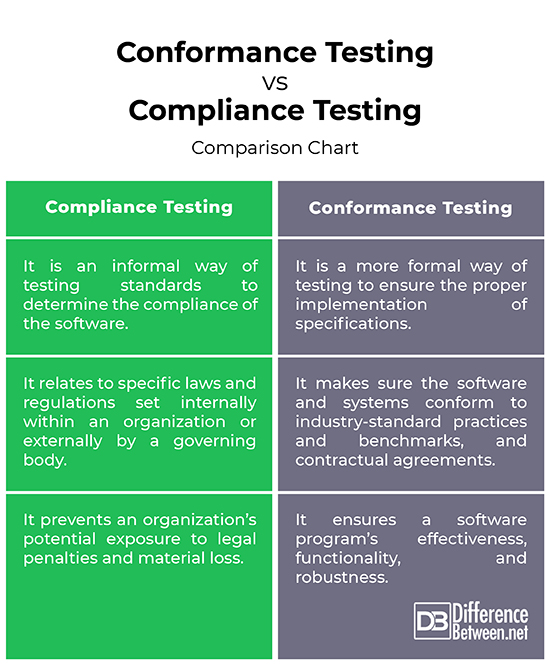Difference Between Conformance and Compliance Testing
The correct execution of software programs or applications is very important, whether it’s in the equipment you use like cell phones, laptops, cars, etc., or in the transactions you undertake (credit/debit purchases, electronic fund transfer, etc.), or just anything that makes your everyday life easier. So, testing software and systems are equally crucial in order to avoid failures. Testing is done throughout the software life cycle, from its beginning to maintenance to production. Safety of the customers and the products are main reasons for conducting tests such as compliance testing or conformance testing.

What is Compliance Testing?
Compliance testing defines standard test methodologies and tools to allow people to test their software products in order to make sure the products were developed in accordance with the IT standards, specifications, procedures, and guidelines. It is a standard software testing approach that ensures that a software program or application adheres to the set laws and regulations. Testing is an essential part of most, if not all industry standards. Compliance means the capability of the software product to adhere to standards, conventions, or guidelines in laws and similar prescriptions.
The goal is to make sure the software product, program, or the system follows a defined set of internal or external standards/regulations before it goes into production. Internal standards are guidelines set by an organization whereas external standards are industry-specific guidelines or procedures set by a governing body. It is often the first test performed when assessing the control environment. Compliance testing prevents an organization’s potential exposure to legal penalties and material loss resulting from their failure to follow industry laws and regulations.

What is Conformance Testing?
Conformance is the act of conformity, meaning the ability of a product or process to meet a specified standard or set guidelines. Conformance to a standard means that you meet the standard requirements as specified. For example, a vehicle must meet some standard specifications to achieve a high quality of conformance, specifications such as excellent fuel economy, reliable engine and performance, low-emission. A certificate of conformity is an assurance that the produced vehicle meets all the technical requirements. Conformance testing ensures the proper implementation of specifications.
The terms conformance testing and compliance testing are often used interchangeably. In fact, conformance testing is sometimes referred to as compliance testing. It mainly involves three steps: preparation, evaluation, and reporting. If the standards or guidelines for conformance are not specified, there is no need of conformance testing. Conformance testing prevents any future risks and ensures a software program’s effectiveness, functionality, and robustness. It focuses on the performance of your software programs and systems, and eventually ensures proper implementation of specifications.
Difference between Conformance and Compliance Testing
Definition
– Compliance testing is an informal way of testing standards to determine the compliance of the software program, application, or system. It ensures that a software program or application adheres to the prescribed standards, guidelines, and regulations that are specific to an industry or organization. Conformance testing is a more formal way of testing to ensure the proper implementation of specifications.
Focus
– The focus of compliance testing is to prevent an organization’s potential exposure to legal penalties and material loss resulting from their failure to follow industry laws and regulations. It relates to specific laws and regulations set internally within an organization or externally by a governing body. Conformance testing is often used interchangeably with compliance testing, but the former is a much broader term that ensures the software or system meets the set industry standards or specific contractual agreements such as service level agreements.
Goal
– The goal of compliance testing is to make sure the software product, program, or the system follows a defined set of internal or external standards/regulations before it goes into production. Compliance testing makes sure the legal or regulatory standards are met. Conformance testing prevents any future risks and ensures a software program’s effectiveness, functionality, and robustness. It makes sure the system conforms to industry-standard practices and benchmarks.
Conformance Testing vs. Compliance Testing: Comparison Chart

Summary
Compliance testing is often used interchangeably with conformance testing and is a non-functional testing technique done before the production phase to certify that the software program or the system adheres to the standard laws and regulations as prescribed by the W3C, IEEE, or ETSI. Well, conformance testing is basically the same except for some subtle differences. For one, it deals with technical aspects of a software program or system to make sure it conforms to the industry standards, benchmarks, and contracts.
What is compliance testing?
Compliance testing is to determine the capability of the software product or system to meet standards, conventions, or regulations in laws and similar prescriptions.
What is the difference between compliance and substantive testing?
Substantive testing is an audit procedure that checks the financial statements and supporting documentation to identify any flaws in the account statements. It looks for errors or material misstatements in financial records. Compliance testing prevents an organization’s potential exposure to legal penalties and material loss resulting from their failure to follow industry laws and regulations
How do you test for conformance?
Conformance mainly involves three steps: preparation, evaluation, and reporting. The type of testing is based on the phase of the development cycle. The most effective technique for conformance testing is the inspection process.
What are the 3 types of conformity?
According to Herbert Kelman, the three major types of conformity are compliance, identification, and internalization.
What are the four methods of compliance?
The four common techniques of compliance include: the “door-in-the-face”, the “foot-in-the-door”, the “lowball”, and the “that’s-not-all” techniques.
Is a Certificate of conformance the same as a Certificate of compliance?
A Certificate of Conformance is basically the same as the Certificate of Compliance which is an authenticated document that states the products or services meet the specified requirements, norms, and standards.
- Difference Between Caucus and Primary - June 18, 2024
- Difference Between PPO and POS - May 30, 2024
- Difference Between RFID and NFC - May 28, 2024
Search DifferenceBetween.net :
Leave a Response
References :
[0]Ahmed, Ashfaque. Software Testing as a Service. Florida, United States: CRC Press, 2009. Print
[1]Perry, William E. Effective Methods for Software Testing, CafeScribe: Includes Complete Guidelines, Checklists, and Templates. New Jersey, United States: John Wiley & Sons, 2007. Print
[2]Chao, Feng, at al. Protocol Conformance Testing Using Unique Input/Output Sequences. Singapore: World Scientific, 1997. Print
[3]Carmona, Josep, et al. Conformance Checking: Relating Processes and Models. Berlin, Germany: Springer, 2018. Print
[4]Homès, Bernard. Fundamentals of Software Testing. New Jersey, United States: John Wiley & Sons, 2013. Print
